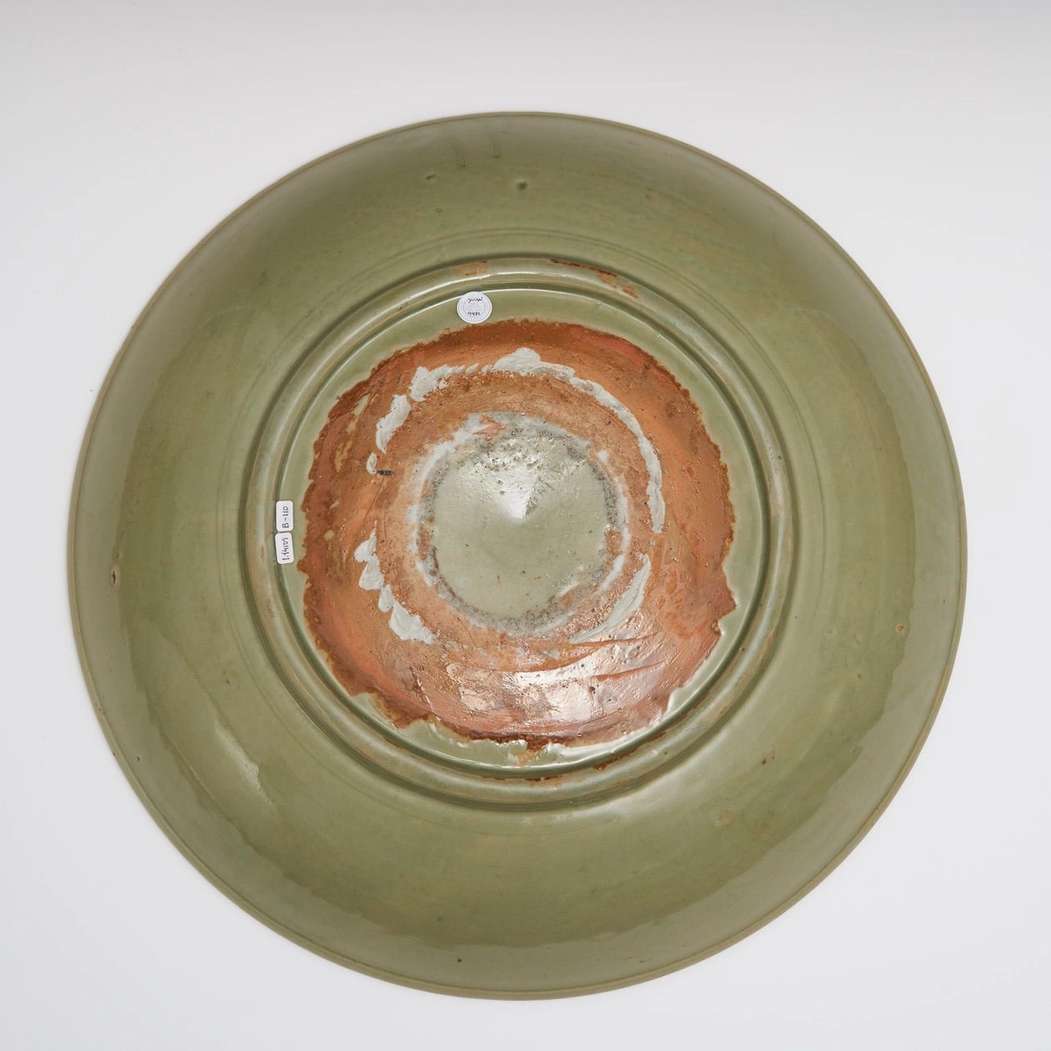Click the above image to zoom
Chinese Longquan ceramic charger carved with flowers and Jin Yu Man Tang[(wishing a) Large House (hall) filled with gold and jade], Yuan/early Ming.
Stock Number: 4488
Very large Chinese Longquan ceramic saucer-shaped charger carved with flowers and Jin Yu Man Tang[(wishing a) Large House (hall) filled with gold and jade] in four panels, 13th/14th century, Yuan/early Ming, d. 49,8 cm, 19¾ in. 1.14109
Provenance: South German collection purchased from Otto Bernheimer, Munich, April 1938.
Illustrated: Yuan to Qing Ceramics, by A. Varela Santos, cat. 01.
Literature:
• The Art of the Chinese Potter, from the Han dynasty until the end of the Ming, by R.L. Hobson & A.L. Hetherington, no. 301 from 1500 London 1923, plate LXX, fig. 1 for a vase with shou and fu characters;
• Chinese Ceramics in the Bauer Collection, by J. Ayers, 1999 Geneve, vol. I, p. 90, cat. 45 for a covered wine jar with Chinese characters dated Yuan or early Ming;
• The Great Fortune, Das Grobe Glück, 2002 Berlin, by G. Weishaupt, p. 316, cat. 349 for a vase with animal handles with rings the characters fu (fortune) and shou (longevity) in linglong (open work) in the body dated from the Yuan dynasty.
◆ Carved and incised saucer-shaped charger strongly potted with deep, rounded side, freely incised on the interior with a leafy peony spray within a double line, the well with four panels enclosing four characters alternating with four panels enclosing leafy peony sprays, covered entirely with a light sea-green celadon glaze pooling in the grooves of the decoration, except for an unglazed ring on the base burnt orange in the firing.
The four letters (Jin Yu Man Tang) means “Large house (Hall) filled with gold and jade”. This is a wish for great fortune. It is of note that the word for fish in Chinese, yu, provides a rebus for “abundance”. Goldfish suggest an abundance of gold. A school of goldfish swimming in a pond (tang) provides a rebus for the phrase jinyu mantang, offering a wish that the household will be filled with gold and jade.
◆ The Longquan kilns of the Yuan dynasty specialized in the production of celadon with a light greyish white body. The industry developed further. Kiln owners tried to meet the needs of the Mongolian rulers and buyers from Southeast Asia and West Asia, and produced new products such as big plates, big vases and cups with high stem foot, and bowls which were decorated with incised, carved, moulded and hollowed out patterns of great variety. However, during the middle and late Yuan, glazing became simplified: most of this celadon had only one layer of green glaze. The glaze became thinner and its colour was mainly yellowish green or greyish green. The body of the vessels become thicker with thick footing. There was also some change in firing practice: the Longquan celadon were now supported by a ring dish-like pad resulting in a ring of unglazed biscuit near the rim at the base.
◆ Otto Bernheimer (1877 - 1960) was an art collector and successful antiques dealer with an international reputation. Founded in Munich in 1864 by Lehmann Bernheimer, the firm opened as a shop for textiles and oriental carpets before expanding to include Italian Renaissance furniture, French antiques, tapestries, porcelain and other objects d’art. By 1900 Bernheimer Fine Old Masters had become purveyors to the Court of Bavaria, and included members of the European aristocracy and American magnates among their clients.
After the death of his father in 1918 Otto took over the company; however, due to the difficult economic situation, business was bad. After the Nazis came to power, the business volume increased at first because premises were needed for prestigious events. In the Night of Broken Glass in 1938, the shop windows were smashed and Otto Bernheimer imprisoned in Dachau. By intervention of the Mexican government, however, he was freed and the family emigrated all around the world.
In 1948, Otto Bernheimer returned to Munich, rebuilt his company once again and fought for the restitution of the family’s property. On his initiative was founded in 1956, at the start of economic miracle, the "German Art and Antiques Fair" in Munich and Bernheimer was elected president of the German art trade association. In addition to the commercial building at Lehnbachplatz Otto Bernheimer in Munich had a country house in Feldafing.
His grandson Konrad took over the business in 1977. Under his directorship, the gallery began to develop an interest in Old Masters, specializing in European schools from the 16th to the 19th century. More recently his daughters enlarged the business to incorporate first photography and later contemporary art.
碩大的中國龍泉窯刻花大盤,紋飾為刻花花卉和 “金玉滿堂” 四個開光大字。元代/明早期。 口径:49.8厘米,19¾ 英寸。
藏品出處:德國南部私人收藏,于1938年4月慕尼黑購自Otto Bernheimer。
圖例:《元代至清代陶瓷》,作者阿.瓦瑞拉.桑托斯,2016/2017, 目录 01。
参考文献:
•《從漢代到明末的中國製陶藝術》,作者R.L. Hobson及A.L. Hetherington,1923年倫 敦出版1500 本,編號第301號,參見圖版70,圖1福壽紋瓶;
•《鮑爾收藏中國陶瓷》,作者J. Ayers,1999年日內瓦出版,見卷一,第90頁,編號45元至明初, 寫有漢字的帶蓋酒罐一件;
•《偉大的財富》,作者G. Weishaupt,2002柏林出版,見第316頁,編號349一件元代玲瓏鏤空 福壽紋雙活環獸耳瓶。
◆青釉刻牡丹紋碟型大盤。此盤胎體厚重,深腹,弧壁,盤心雙圈內暗刻纏枝牡丹紋,內壁刻“金玉滿堂”四字,間有四處圓形纏枝牡丹開光,器身滿施淡淡海青色釉,流淌自然,紋飾清晰,器足一圈無釉并顯火石紅。“金玉滿堂”代表了人們的美好願望及對財富的嚮往。
中文字“魚”與“餘”諧音,金魚可通“多餘的金子”。數目眾多的金魚在池(塘)中暢游,有“金玉滿堂”之美意。
◆元代龍泉窯口燒製的青瓷器身通常顯示淡淡的灰白色,隨後技術持續發展。為了滿足蒙古族統治者及東南亞和西亞買家的需求,窯主們燒製出新的瓷器類型,包括大盤,大瓶和高足杯,還有各類帶刻劃,模製及掏空式樣的瓷碗。但是到了元代中晚期,瓷器的施釉變得越來越簡單:大部份青瓷只上一層釉。釉面變得越來越薄,顏色也隨之大多呈現黃綠及灰綠色。器皿胎體逐漸變厚,底足也在變厚。燒製的方法亦有所改變:龍泉青瓷使用圓形墊燒技術,以致器底一圈無釉露胎。
◆ Otto Bernheimer先生(1877-1960)曾是一位世界知名的藝術品收藏家及成功的古董商人。 Lehmann Bernheimer先生于1864 年在慕尼黑成立自己的公司,起初主要經營紡織品及東方式地毯, 隨後擴展經營意大利文藝復興時期傢具,法國古董,織錦掛毯,瓷器及其他藝術品。直至1900年Bernheimer Fine Old Masters公 司已成為巴伐利亞法院的供應商,並且很多歐洲貴族及美國的產業 大王和富豪都成為 了公司的客戶。
1918年在父親去世之後,Otto接管公司。不幸的是經濟慘澹導致生意艱難。納粹掌權後,因為各處需要舉行盛大宴會及儀式,生意開始好轉。1938年水晶之夜(11月大迫害)爆發,商店窗戶遭到砸碎破壞,Otto Bernheimer被關進達豪集中營。受到墨西哥政府干涉后,他被釋放,整個家族移民到 世界各地。
1948年Otto Bernheimer返回慕尼黑,重新建造戰用辦公室和他的公司,以及極力追討家族產業。 1956年經濟奇蹟開始之際,在Bernheimer的帶領下,德國藝術品及古董展銷會在慕尼黑成立。
Bernheimer被推舉為德國藝術品及貿易協會主席。除了在慕尼黑Lehnbachplatz的一幢商用大樓,Otto Bernheimer還在費爾 達芬格擁有一棟鄉村別墅。
他的孫子Konrad在1977年接管生意。在Konrad的管理下公司開始涉足經營早期繪畫大師作品,尤其是16至19世紀的歐洲畫作。最近他的女兒們更共同擴展經營最早期照片和後期當代藝術。


